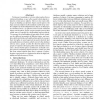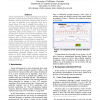117
click to vote
SSDBM
2005
IEEE
15 years 6 months ago
2005
IEEE
To discover knowledge or retrieve information from a relational database, a user often needs to find objects related to certain source objects. There are two main challenges in b...
96
Voted
SSDBM
2005
IEEE
15 years 6 months ago
2005
IEEE
Recent advancements in sensor technology have made it possible to collect enormous amounts of data in real time. However, because of the sheer volume of data most of it will never...
SSDBM
2005
IEEE
15 years 6 months ago
2005
IEEE
100
click to vote
SSDBM
2005
IEEE
15 years 6 months ago
2005
IEEE
Scientific investigations have to deal with rapidly growing amounts of data from simulations and experiments. During data analysis, scientists typically want to extract subsets o...
115
click to vote
SSDBM
2005
IEEE
15 years 6 months ago
2005
IEEE
As with many large organizations, the Government's data is split in many different ways and is collected at different times by different people. The resulting massive data he...
123
click to vote
SSDBM
2005
IEEE
15 years 6 months ago
2005
IEEE
Modern database applications including computer-aided design, multimedia information systems, medical imaging, molecular biology, or geographical information systems impose new re...
128
click to vote
SSDBM
2005
IEEE
15 years 6 months ago
2005
IEEE
Modern geographic information systems do not only have to handle static information but also dynamically moving objects. Clustering algorithms for these moving objects provide new...
104
click to vote
SSDBM
2005
IEEE
15 years 6 months ago
2005
IEEE
Data products generated from remotely-sensed, geospatial imagery (RSI) used in emerging areas, such as global climatology, environmental monitoring, land use, and disaster managem...
133
click to vote
SSDBM
2005
IEEE
15 years 6 months ago
2005
IEEE
The widespread use of sensor networks in scientific and engineering applications leads to increased demand on the efficient computation of the collected sensor data. Recent rese...
109
click to vote
SSDBM
2005
IEEE
15 years 6 months ago
2005
IEEE
Advanced Data Mining applications require more and more support from relational database engines. Especially clustering applications in high dimensional features space demand a pr...


